
Martin County is a county located in the Treasure Coast region of the state of Florida, in the United States. As of the 2010 census, the population was 146,318. Its county seat is Stuart. Martin County is in the Port St. Lucie, FL Metropolitan Statistical Area.

Jensen Beach is a census-designated place (CDP) in Martin County, Florida, United States. The population was 11,707 at the 2010 census. It is part of the Port St. Lucie, Florida Metropolitan Statistical Area.

American colonial architecture includes several building design styles associated with the colonial period of the United States, including First Period English (late-medieval), French Colonial, Spanish Colonial, Dutch Colonial, and Georgian. These styles are associated with the houses, churches and government buildings of the period from about 1600 through the 19th century.

The Old Martin County Court House, built in 1937, is a historic Art Deco style courthouse building located at 80 East Ocean Boulevard in Stuart, Martin County, Florida. In 1989, it was listed in A Guide to Florida's Historic Architecture, published by the University of Florida Press. On November 7, 1997, it was added to the U.S. National Register of Historic Places. On March 15, 2007, it was added to the Martin County Historic Register by the Martin County Historic Preservation Board. It is now known as the Courthouse Cultural Center and is the headquarters of the Arts Council, Inc., the designated local arts agency for Martin County.
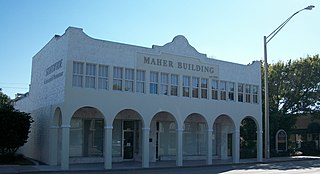
The Maher Building, also known as the Illinois Hotel, is a historic building in Vero Beach, Florida. Originally located at 1423 Osceola Boulevard, now 20th Street, the Maher Building housed the Maher department store owned by William J. and Catherine Maher. The store retained a reasonable reputation throughout the city for offering apparel at "pleasing prices". Although no lives were lost when the original store building burned down in November 1919, the tragedy resulted in its complete loss. After Maher recovered from the damages, he reordered stock from St. Louis and commissioned a new brick and concrete structure on the building's original site. On October 28, 1994, this structure was added to the U.S. National Register of Historic Places.
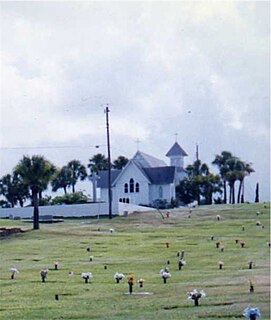
All Saints' Episcopal Church, Waveland, is an historic Carpenter Gothic church built in 1898 on Crossroads Hill in Waveland, now part of Jensen Beach, Florida. It is the oldest church building located in what is now Martin County, Florida. It is also the northernmost parish in the present-day Episcopal Diocese of Southeast Florida. When the church was built the land it is on was in Brevard County. From 1910-25, it was in St. Lucie County. Since 1925 it has been in Martin County. Its rector, W. Frisby Hendricks III recently, retired and the parish is starting the search process to call a new rector.

The Bankers Trust Company Building is an office building located at 205 West Congress Street in Downtown Detroit, Michigan, within the Financial District. Designed by Wirt C. Rowland of Smith, Hinchman & Grylls and completed in 1925, the ornately modeled building is an exquisite example of Italian Romanesque Revival architecture.

The Wayne State University historic district consists of three buildings on 4735-4841 Cass Avenue in Midtown Detroit, Michigan: the Mackenzie House, Hilberry Theatre, and Old Main, all on the campus of Wayne State University. The buildings were designated a Michigan State Historic Site in 1957 and listed on the National Register of Historic Places in 1978.

The Edsel and Eleanor Ford House is a mansion located at 1100 Lake Shore Drive in Grosse Pointe Shores, northeast of Detroit, Michigan; it stands on the site known as "Gaukler Point", on the shore of Lake St. Clair. The house became the new residence of the Edsel and Eleanor Ford family in 1928. Edsel Ford was the son of Henry Ford and an executive at Ford Motor Company. The estate's buildings were designed by architect Albert Kahn, its site plan and gardens by renowned landscape designer Jens Jensen. The property was listed on the National Register of Historic Places in 1979, and was designated a National Historic Landmark in 2016.

The Golden Gate Building, built in 1925, is an historic real estate and land development office building located on State Road A1A at 3225 South East Dixie Highway in the unincorporated community of Golden Gate south of Stuart in Martin County, Florida. It was built by the Golden Gate Development Company to serve as the sales office for its 200 block subdivision called Golden Gate. which was a re-subdivision of a part of the 1911 subdivision called Port Sewall. The Florida Land Boom, however, collapsed before it could be used as such. In 1926, it became the Port Sewall Post Office and it was later used as a church and then as an art studio, before being abandoned and falling into disrepair.
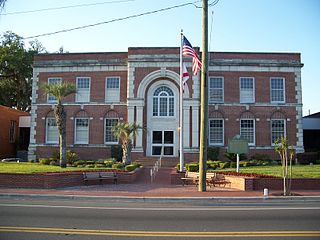
The Union County Courthouse is an historic redbrick courthouse building located in Lake Butler, Florida. Designed by John Pearson of Gainesville in the Classical Revival style, it was built in 1936 by the Works Project Administration to serve Union County, which had been carved out of Bradford County in 1921. It is located on the site of a former courthouse that served the county of New River, Bradford's original name. In 1967 additions to the courthouse were designed by Harry E. Burns, Jr., and were built by Vinson J. Forrester, Jr.

The Old Flagler County Courthouse is an historic two-story redbrick courthouse building located at 200 East Moody Boulevard in Bunnell, Florida. Designed by Wilbur Talley in the Classical Revival style, it was built in 1924 by O. P. Woodcock to serve Flagler County which had been created in 1917. It was the county's second courthouse building and its first purpose built one. In 1985 a three-story addition was attached to its rear. In January 2007 the 1924 building was closed due to safety problems with its roof. By January 2008, the 1985 addition had also been vacated due to structural problems. Courthouse operations are now housed at the Kim C. Hammond Justice Center 1769 East Moody Boulevard.

The Old Charlotte County Courthouse is an historic two-story yellow brick courthouse building located at 227 Taylor Street in Punta Gorda, Florida, Florida. Designed in the Classical Revival style by architects Leitner and Henson of St. Petersburg, it was built between 1927 and 1928 by Paul H. Smith of Haines City. Additions were made to the building the 1960s and 1980s but in 1999 it was replaced by a new Justice Center and then fell into disuse. In 2005, the additions having been demolished, the Board of County Commissioners undertook the restoration and renovation of the original 1928 structure that remained. It was reopened to the public in a ceremony on February 29, 2008.

Rosemount is a historic plantation house near Forkland, Alabama. The Greek Revival style house was built in stages between 1832 and the 1850s by the Glover family. The house has been called the "Grand Mansion of Alabama." The property was added to the National Register of Historic Places on May 27, 1971. The Glover family enslaved over 300 people from 1830 until 1860.
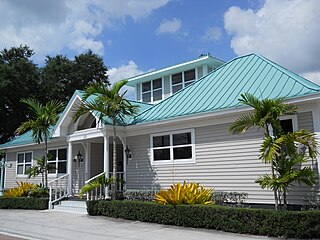
The Dudley-Bessey House, also known as the Major Phillip B. H. Dudley Home, is an historic two-story, single-family house located at 110 SW Atlanta Avenue in Stuart in Martin County, Florida. Built in 1909 for Phillip B. H. Dudley, it features a first floor central hallway which runs from the street-side entrance straight though to the main entrance which faces the Halpatiokee River, now known as the South Fork of the St. Lucie River. All interior rooms open from this hallway. It later became home of Hubert W. Bessey, 1855–1918, one of the founders of Stuart, Sometime before 1989 the street side was altered by the addition of a long porch with a flat roof and a sloped roof over the entryway. Today most of the front porch has been enclosed and incorporated into the building, leaving only a sheltered entryway with a grander sloped roof over the entry way and hip roofs over the each side of the former porch. The interior has been restored and the building became the offices of United Yacht Sales.

Woodmen Hall is an historic 2-story wooden Woodmen of the World building located 217 SW Akron Avenue, corner of SW 3rd Street in Stuart, Martin County, Florida. It was built between 1913-1914 by local master carpenter Sam Matthews. Like many fraternal buildings built in the late 19th century and early 20th century, the ground floor was designed for commercial use, while the upper floor was designed for use as a meeting room for Pineapple Camp No. 150, Woodmen of the World as well as community groups. Prominent members of Pineapple Camp include George W. Parks, who had a general store in what is now the Stuart Heritage Museum and in 2000 was added to the state's list of Great Floridians. Early users of the first floor include H.A. Carlisle's Feed Store. From the 1930s until 1959, Southern Bell used the first floor as a business office, while the Stuart telephone exchange was located on the second floor. Recent uses have included a church and a coffee house and open mic music venue. One group performing in it even calls itself, Woodmen Hall. The building has been recently renovated through the efforts of Stuart Main Street. An elevator has been added. The double outside staircases on the eastern part of the south side have been reduced to one, while an outside staircase has been added on the north side toward Akron Avenue. The two large front windows differ from those shown in a 1925 photograph. "

The Jensen Alvarado Ranch is a historic park and museum in Jurupa Valley, California, USA, and is operated by the Riverside County Regional Park and Open-Space District. It can be accessed from 4350 Riverview Drive, or 4307 Briggs Street. It was the first kiln-fired brick building built in Riverside County, and is the oldest non-adobe structure in the Inland Empire.
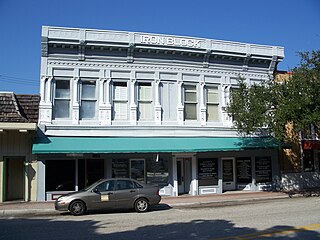
The Iron Block Building, so named for the words Iron Block embossed high on its front facade is an historic two-story commercial building located at 530 12th Street West across from the Manatee County Courthouse in Bradenton, Manatee County, Florida. The Iron Block Building was built in 1896 in the cast iron style of architecture by Dr. Charles Ballard. It originally housed Reed's Cash Store. The building would be moved from its original location at the southwest corner of Manatee Avenue and 12th Street West to its present location in 1921. It has been restored and according to A Guide to Florida's Historic Architecture features original "pressed metal facades on three sides."
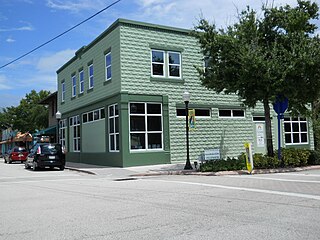
The Feroe Building, also known as the Harry C. Feroe Building, is an historic two-story commercial building located at 73 S.W. Flagler Avenue, corner of S.W. St. Lucie Avenue in Stuart, Martin County, Florida. To its north of along Flagler Avenue is Fellowship Hall built in 1912 as the Bank of Stuart, while to the east along Flagler Avenue is the Lyric Theatre built in 1925 and later expanded. Built and named for Harry C. Feroe, who was associated with Charles C. Chillingworth in the development of Palm City, it was built in 1913 by local contractor Sam Matthews using locally manufactured concrete blocks which had been cast by Frank Frazier to look like stones. The ground floor, which fronted on St. Lucie Avenue and featured cast-iron columns, was designed for retail use, while the second floor, which was accessed by stairs from an entrance on the Flagler Avenue side of the building, was designed for office space. Later in 1913 the Florida East Coast Railway built its now demolished Stuart Depot directly across Flagler Avenue from the building, which enhanced its value. Early ground floor tenants were the Stuart post office in the corner space and the Stuart Drug Company to its north. After the post office moved out, its space was occupied by various other businesses until eventually being combined with the drug store space. Marilyn's Pharmacy, a Rexall agency, occupied the space in the 1960s and early 1970s. In the middle 1980s local lawyer Larry M. Stewart bought the building and renovated it for his law offices. The main entrance was moved to the east side of the building with access from a courtyard which is entered from Flagler Avenue through an arched wrought-iron gate. In 2020, the building was purchased and occupied by one of the premier law firms in Stuart, Kibbey Wagner, PLLC. They renovated and updated the building’s exterior and interior.
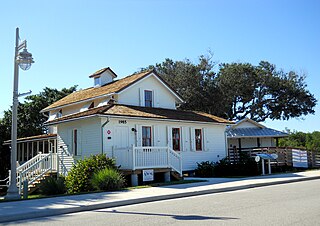
The Capt. Henry E. Sewall House is an historic wooden house now located in Indian RiverSide Park in Jensen Beach, in Martin County, Florida. Local pioneer and developer Capt. Henry E. Sewall built it in 1889 at the southern tip of Sewall's Point, the peninsula and town which bear his family name. When Capt. Sewall became the postmaster of Sewall's Point, the house served also as the Sewall's Point post office. Next to the house Capt. Sewall also built a freight dock that extended into the St. Lucie River along with a storage building at its end.





















